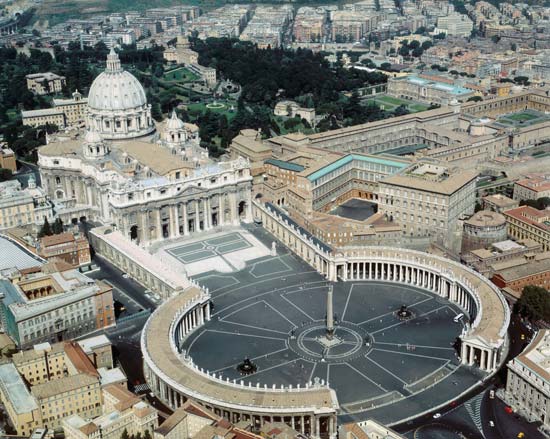Baroque architecture
Contents |
[edit] Introduction
Baroque architecture is a style that emerged in Italy in the late-16th century.
It was a more theatrical version of Renaissance architecture, with dramatic lighting and colour, illusory effects such as trompe l’oeil, and designs that played games with architectural features, sometimes leaving them incomplete.
Its buildings typically include central towers, domes, portico or other central projections in the main façade. As Baroque architecture coincided with European colonialism, it can be seen throughout much of the world; and in some regions, notably Germany and colonial South America, it lasted until the 18th century.
[edit] History
Baroque developed in the Counter-Reformation period, when the Catholic Church needed to reassert its waning influence across Europe in the face of the Protestant Reformation. One way of attracting new followers was to create overtly emotional and sensory displays in art and architecture. Church architecture appealed as much to the emotions as to the intellect of the faithful, attempting to persuade them into unconditional loyalty to the church. Approaching and entering a church became a symbolic, sensorial and mysterious experience.
While initially finding form in church and cathedral design, the style was later used as a visual demonstration of absolutist regimes in the form of elaborate royal palaces.
The late Baroque style is often referred to as Rococo or, in Spain and Spanish America, as Churrigueresque.
[edit] Style and characteristics
Baroque architecture is characterised by dynamic designs and complex architectural plan forms; intended to heighten feelings of motion and sensuality, and frequently based on the oval. There is often a mixture of the repetition, break-up and distortion of Renaissance classical motifs.
- Grandeur.
- Contrast.
- Curves and twists.
- Rich surface treatments.
- Gilded statuary.
- Bright colours.
- Vividly painted ceilings.
- Fragmented or deliberately incomplete elements.
- Large-scale frescoes.
- Dramatic central projections on an external façade.
- Use of plaster or stucco, marble or faux finishing.
- Illusory effects such as trompe l’oeil.
- Pear-shaped domes (more common in Eastern Europe baroque).
[edit] Notable buildings
The most notable practitioners of the baroque style in Italy included Gian Lorenzo Bernini, Carlo Maderno, and Francesco Borromini. Developing later, in central Europe the most notable architect was Johann Bernhard Fischer von Erlach. In Britain, baroque was adopted by Christopher Wren and Nicolas Hawksmoor.
Some of the most notable buildings incorporating the baroque style are:
- St. Paul’s Cathedral, London.
- Winter Palace, St. Petersburg.
- Karlskirche, Vienna.
- Palace of Versailles, Versailles.
- Les Invalides, Paris.
- St. Peter’s Square, Vatican City.
- San Carlo alle Quattro Fontane, Rome.
- St. John’s Co-Cathedral, Valletta, Malta.
[edit] Related articles on Designing Buildings
- Architectural styles.
- Art Deco.
- Bauhaus.
- Beaux Arts style.
- Belvedere.
- Classical architecture
- Eclecticism.
- Fountaine Hospital Almshouse.
- International Style.
- Italian Renaissance Revival style.
- Modernist architecture.
- Monopteros.
- Neoclassical architecture.
- Palladian architecture.
- Piazza.
- Postmodern architecture.
- Restoring Orleans House Octagon.
- Rococo.
- Scagliola.
- Stuart architecture.
- Trompe l’oeil.
- Zeitgeist.
Featured articles and news
Infrastructure that connect the physical and digital domains.
Harnessing robotics and AI in challenging environments
The key to nuclear decommissioning and fusion engineering.
BSRIA announces Lisa Ashworth as new CEO
Tasked with furthering BSRIA’s impressive growth ambitions.
Public buildings get half a million energy efficiency boost
£557 million to switch to cleaner heating and save on energy.
CIOB launches pre-election manifesto
Outlining potential future policies for the next government.
Grenfell Tower Inquiry announcement
Phase 2 hearings come to a close and the final report due in September.
Progress from Parts L, F and O: A whitepaper, one year on.
A replicated study to understand the opinion of practitioners.
ECA announces new president 2024
Electrical engineer and business leader Stuart Smith.
A distinct type of countryside that should be celebrated.
Should Part O be extended to existing buildings?
EAC brands heatwave adaptation a missed opportunity.
Definition of Statutory in workplace and facilities management
Established by IWFM, BESA, CIBSE and BSRIA.
Tackling the transition from traditional heating systems
59% lack the necessary information and confidence to switch.
The general election and the construction industry
As PM, Rishi Sunak announces July 4 date for an election.
Eco apprenticeships continue help grow green workforce
A year after being recognised at the King's coronation.
Permitted development rights for agricultural buildings
The changes coming into effect as of May 21, 2024.






















